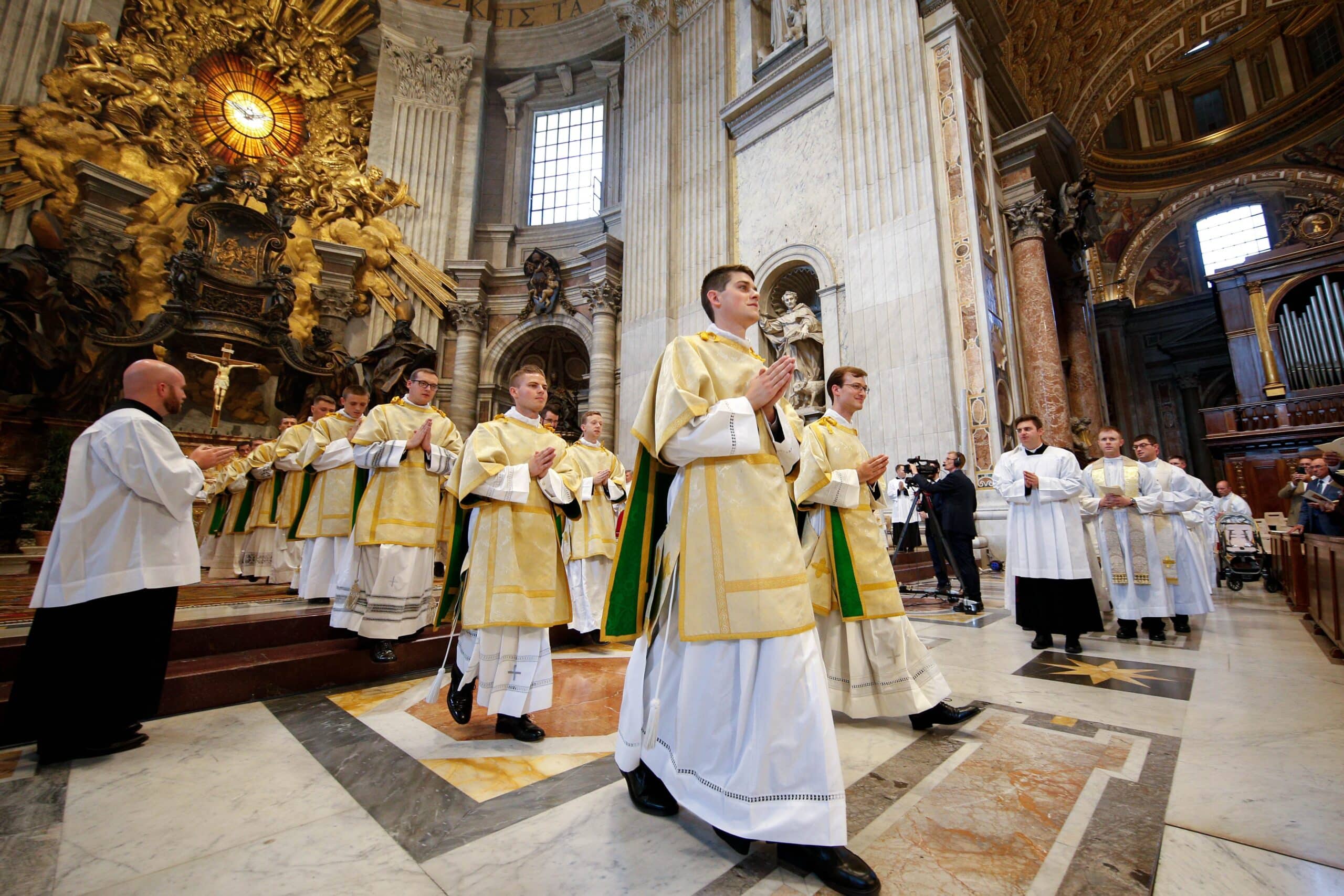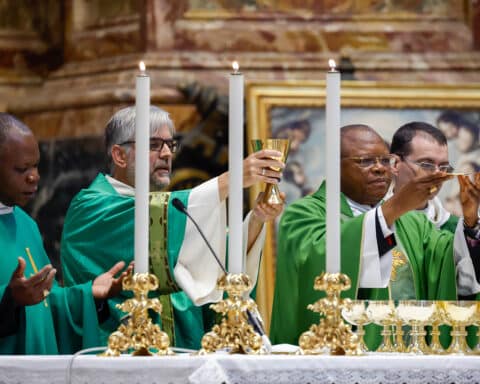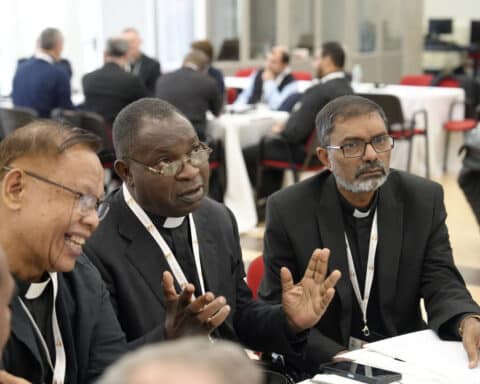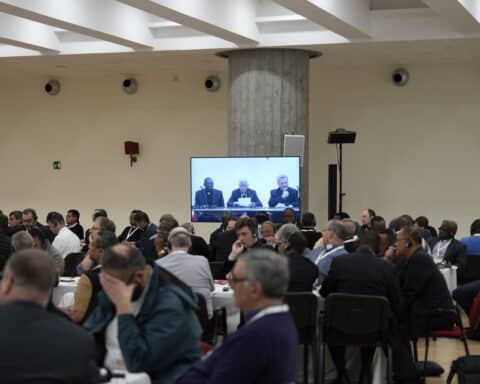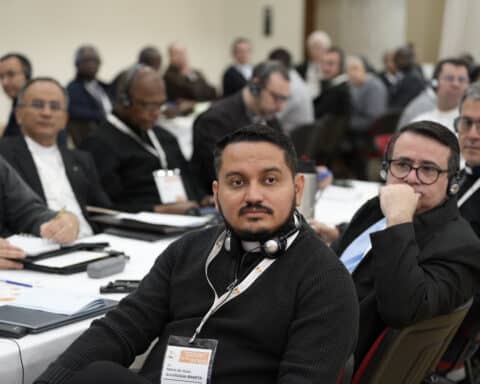Is the transitional diaconate still necessary? In other words, is it necessary for a priest to first be ordained a deacon before being ordained to the priesthood? In the recent essay “The Catholic Church doesn’t need transitional deacons.” for America Magazine, Deacon William T. Ditewig argues a resounding no. According to him, the diaconal step on the path to the priesthood is no longer necessary or beneficial. However, I disagree. Reimaging the diaconate should proceed with greater caution and theological care.
Discontinuity or reform?
In the conversations on the potential reform of the diaconate, as voiced by Cardinals McElroy and Cupich and detailed by Deacon Ditewig, we encounter a pivotal theological crossroad: Should the Church embrace a hermeneutic of discontinuity, severing the traditional sequential path toward priesthood in favor of a reimagined diaconate? Or should it instead view these developments through a hermeneutic of reform articulated by Pope Benedict XVI?
Pope Benedict XVI warns of the dangers inherent in a hermeneutic of discontinuity, which he describes as a “rupture” from the past. This approach not only misinterprets the nature of ecclesial reforms but also risks a split within the Church. It threatens a fissure between the pre-conciliar and post-conciliar Church. The proponents of discontinuity argue that the Second Vatican Council and long-standing traditions, such as the transitional diaconate, do not fully convey the spirit of ecclesial renewal envisioned by the modern Church. They advocate for a radical departure from these traditions, saying such a break is necessary to address contemporary pastoral and theological challenges.
Contrastingly, Pope Benedict XVI champions a hermeneutic of reform, emphasizing renewal within the continuity of the Church’s life and tradition. This approach respects the Church’s rich heritage while allowing for organic development, aligning closely with the true spirit of the Second Vatican Council. The hermeneutic of reform does not reject past teachings but seeks to understand and integrate them into the living context of the Church’s journey through history.
Reimagining the diaconate
The discussion surrounding the diaconate, particularly its necessity as a transitional stage to the priesthood, must be approached with the hermeneutic of reform. This perspective allows us to appreciate the diaconate’s integral role within the sacramental life of the Church and its historical development as part of a continuum rather than as a relic that impedes modernization.
By embracing this approach, we acknowledge that any development in the understanding and practice of the diaconate should not simply discard the established order. Instead, it should reflect a deeper engagement with the Church’s doctrinal foundations and a commitment to fostering a more profound realization of these orders in contemporary ecclesial life.
Thus, to respond to Cardinal McElroy, Cardinal Cupich and Deacon Ditewig’s calls to “reimagine” the diaconate, it is crucial to discern whether these reforms truly reflect a genuine development of the Church’s understanding of ministry or if they spring from an ideological pursuit of novelty that risks disorienting the faithful and disrupting the sacramental coherence upheld by the Church for centuries.
Practical experience and a theology of ministry
Deacon Ditewig’s concerns aren’t all theoretical. He delves into the practical dimensions of the transitional diaconate, emphasizing the experiential benefits it provides for those preparing for priestly ordination. He discusses how this has historically provided seminarians with practical ministerial experience before assuming the full responsibilities of the priesthood.
Deacon Ditewig’s argument, however, predominantly adopts a sociological perspective, analyzing the role and function of the diaconate in terms of its utility and effectiveness in preparing candidates for the priesthood. This approach tends to view the diaconate through a lens of functionality and pragmatism. It focuses on what deacons do – their tasks and roles – rather than on who they are in the ontological sense: Sharers in the identity of Christ the Servant. The lack of Scripture and references to Tradition and the Magisterium in Deacon Ditewig’s discussion betrays the gap between the theological approach to the diaconate and his more modern, functional analysis.
To address the gaps in Ditewig’s approach, one must explore how the diaconate, as a sacramental sign, uniquely participates in the mystery of salvation and how this identity should inform and transform the practical outworking of the deacon’s ministry. It would also necessitate a return to the patristic and conciliar sources that articulate the role of the deacon in the life of the Church, ensuring that any discussion on the evolution or “revisioning” of the diaconate remains anchored in a profound understanding of its sacred nature.
Transitional vs. permanent
Deacon Ditewig critiques the terms “transitional” and “permanent” commonly used to describe deacons. He argues that these labels are misleading and reductive, suggesting they create a division in the single Order of Deacons. Deacon Ditewig emphasizes that all deacons share the same sacramental grace imparted by ordination, regardless of whether they are eventually called to the priesthood or remain deacons permanently.
While Deacon Ditewig’s critique of the terminology is compelling and aligns with a more sacramental understanding of the diaconate, his characterization of the transitional diaconate as an “apprenticeship” also falls short of recognizing this order’s full theological and ontological significance. Describing the transitional diaconate in terms of apprenticeship focuses too heavily on the functional aspects of the role, viewing it merely as preparation or training for the priesthood.
By reducing the transitional diaconate to an apprenticeship, there is a failure to fully acknowledge this sacramental grace as a true participation in Christ’s servanthood. Such a reduction can lead to an undervaluation of the diaconate’s unique and essential contributions to the Church, including its roles in liturgy, preaching, and charity, which are not merely steps towards priesthood but are manifestations of the deacon’s real and permanent participation in the ministry of Christ.
Therefore, while I agree with Ditewig’s critique of the problematic terminology of “transitional” and “permanent,” it is also essential to challenge his characterization of the transitional diaconate as an apprenticeship, advocating instead for a deeper theological appreciation of the diaconate as a full and authentic expression of ordained ministry in its own right.
Service: Essential to the priesthood
Properly understood, the transitional diaconate is not only a preparatory stage for the priesthood but also a profound sacramental expression of diakonia — “service” — which is essential to the priesthood. This period should imbue future priests with a deep-rooted understanding of service as a fundamental dimension of their ministry, aligning with Christ’s mission to serve.
Theologically, when seminarians are ordained as transitional deacons, they undergo an ontological change, configuring them to Christ the Servant. This configuration is not merely temporary; it permanently shapes their identity as ministers called to serve, fundamentally influencing how they will live out their priesthood.
The service learned and lived as a deacon does not cease upon priestly ordination; rather, it becomes the foundation through which priestly ministry is expressed. Every sacramental action and pastoral encounter a priest engages in is deeply imbued with the spirit of diakonia. The priest approaches the altar and the sacraments not as a lord but as a servant. He offers the sacrifice of the Eucharist and reconciles sinners not from a position of power but from one of humble service to God’s people.
Carrying Christ into the world
The integration of the diaconate into the priesthood allows the priest to carry the ministry of Christ into the world in a manner that is fundamentally marked by service. This is evident in how priests are called to be with their people, sharing their joys and sorrows and tending to their spiritual and often temporal needs. In performing acts of charity, teaching, counseling and leading, the priest’s actions are an extension of his diaconal ordination. The diaconal character thus does not diminish; instead, it enhances the priestly ministry, enabling the priest to act as a bridge between the sacred liturgy and the lived experience of the faithful.
The dual sacramental character of being both a deacon and a priest facilitates a more holistic approach to pastoral care, where the priest views his ministerial duties through the lens of service. This perspective is crucial in today’s context, where the faithful seek models of leadership that resonate with Christ’s message of love and humility. By living out the diaconal dimensions of their priesthood, priests embody a more authentic expression of Christ’s call to serve, making the Church a true reflection of the servanthood of Christ. The transitional diaconate is integral, not peripheral, to the nature and effectiveness of priestly ministry in the Catholic Church.

